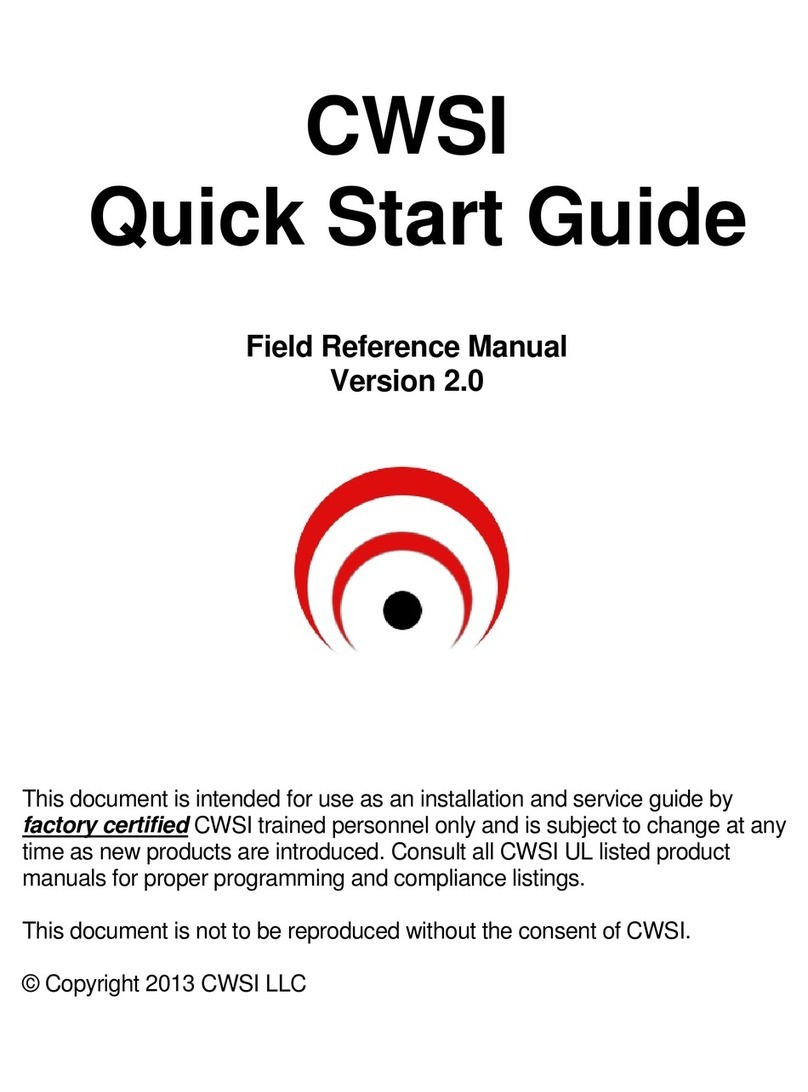
P/N CWSI-IM-310 Rev. F
© 2017 Johnson Controls. All rights reserved. All specifications and other information
shown were current as of document revision date and are subject to change without notice.
screws. Close and lock the pull station using the key provided. Perform the Signal Test
and Alarm Test as outlined in this manual.
Cautions:
1. Make sure the battery is firmly installed in the battery holder with the battery retaining clip
around the battery.
2. The unit must be secured tightly to the wall, so as to not be dislodged.
3. Test the unit after any service or battery change or as often as local or national codes
dictate.
Alarm Operation:
To activate an alarm from the pull station, push in and pull down on the handle. A yellow
indicator under the word push will appear when the pull station is activated. The pull station
remains in the activated position until reset.
When the pull station handle is pulled:
1. An initial alarm signal is transmitted.
2. A 60 second delay occurs. If during this delay the pull station is reset then the alarm
cycle is ended.
3. The continued alarm condition causes a repeat alarm transmission.
4. Another 60 second delay as in step 2 occurs.
5. Step 3 repeats at 60 second intervals until reset.
To reset the pull station, insert the key into the lock and rotate ¼ turn clockwise. Open the
door until the handle returns to normal then close and lock the door. Closing the door
automatically resets the switch to the normal position. Opening the door with the key will
not activate the alarm switch.
LED: The LED is visible through the front of the pull station and will flash twice when an
alarm signal is transmitted.
Alarm Test:
Before testing, notify the proper authorities that maintenance is being performed and the
system will be temporarily out of service. Activate an alarm as described it the Alarm
Operation section of this manual. Verify an alarm is received at the control panel. The pull
station remains in the activated position until reset. The led will flash twice when an alarm is
transmitted. Reset the pull station after alarm reception has been verified at the control
panel.
Signal Test:
The test must be performed while the pull station is held in its intended mounting location.
Initiate the test by placing a strong magnet along the middle left side of the pull station as
shown in figure 1. The model 310 piezo sounder will beep once. A delay of up to 15
seconds will occur followed by either one or two beeps. One beep indicates an
unacceptable location and two beeps indicate an acceptable location. If only one beep is
heard then relocate the model 310 mounting position closer to the nearest repeater or
control panel and perform the test again. Continue this procedure until 2 beeps are
achieved. Do not mount the transmitter unless 2 beeps are heard when performing 5
consecutive signal tests. This test must be performed before and after transmitter
installation. Note: A CWSI model AR-3(A), AR-5 repeater or Control Panel must be
powered up, installed and enrolled before running this test. Refer to the signal survey
section of the control panel manual for more information.
Low battery:
The battery voltage is tested under load every 90 seconds. When a low battery voltage is
detected, a low battery trouble will be transmitted and repeated every 90 seconds. Where
more than one type of trouble exists, all will be repeated every 90 seconds. The led will
flash once when a low battery trouble is transmitted.

























